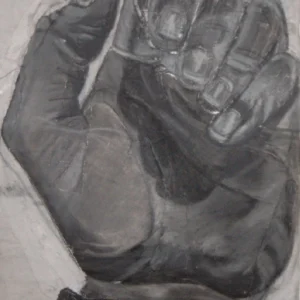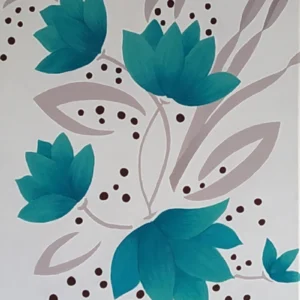Tu-Lips-1
A Fusion of Nature, Desire, and Abstract Beauty
In the world of art, the inspiration for a single piece can come from an unexpected source, weaving together disparate elements into something altogether new, something that speaks to both the intellect and the soul. Tu-Lips-1, a captivating acrylic on canvas painting by Lyn Potrykus, is one such piece, a work of profound elegance, playful sensuality, and visual intrigue. The artist’s skilful blend of colour, form, and symbolic resonance creates a canvas that seems to pulse with life, inviting viewers to explore its depth and to appreciate the tension between abstraction and representation.
At first glance, Tu-Lips-1 is a striking image: a large, open black tulip, its petals unfurling to reveal a heart of vibrant cerise pink. The surreal shape of the flower immediately commands attention, yet there is more to the piece than its immediate visual impact. The composition, featuring the tulip against a stark white background, subtly suggests a marriage of the natural and the fabricated.
The contrast between the deep black of the petals and the lush pink centre evokes a feeling of something rare and extravagant, a natural wonder that has been manipulated, redefined, and reimagined by the artist’s brush. Indeed, this artwork is much more than just a flower, it is an exploration of the complex interplay between beauty, desire, and abstraction.
The Birth of Tu-Lips-1
The inspiration for Tu-Lips-1 emerged from an unlikely source: a rug. As simple as it sounds, the genesis of this painting can be traced to an image L. Potrykus stumbled upon while browsing an online marketplace. The rug in question, the “Keno Floral Symphony Rug” from Rugs USA, captured the artist’s attention with its bold patterns, vibrant colours, and the intriguing way it blended floral elements with an almost geometric abstraction. The colours and shapes in the rug seemed to echo the visual language of both contemporary and classical art, a hybrid of floral beauty and stylized design that immediately sparked Potrykus’s imagination.
Yet, rather than merely replicating the rug’s design, Potrykus took this initial spark and elevated it into something uniquely their own. The tulip in Tu-Lips-1 does not merely echo the floral motif of the rug, it transforms it. What begins as a decorative pattern evolves into an exploration of the tulip’s symbolic weight, its cultural significance, and its transformation into an object of desire. By taking the flower’s form and giving it the exaggerated, almost anthropomorphic shape of lips, Potrykus draws on the universal symbol of sexuality and allure, fusing these elements into a visual metaphor that speaks to the beauty of both nature and the human condition.
Symbolism of the Tulip, From Love to Desire
The tulip itself carries a rich history of symbolism, particularly in Western art and culture. In the 17th century, tulips became synonymous with luxury and excess during the Dutch “Tulip Mania,” a period when the flowers were so highly prized that their bulbs were traded for exorbitant sums. During this time, the tulip represented not only wealth but also fleeting beauty, an ephemeral moment of perfection that could easily slip away. This historical context provides an interesting backdrop for understanding Tu-Lips-1, where the flower seems to simultaneously embody both the transient nature of beauty and its magnetic allure.
Moreover, tulips have long been associated with love, passion, and longing, often seen in classical art as a symbol of the heart and the soul’s desires. In Tu-Lips-1, the flower’s exaggerated form, its petals curling outwards like a pair of lush, kissable lips, reinforces this symbolism. There is an undeniable sensuality to the piece, as the cerise pink centre draws the eye, beckoning like a soft invitation. The lips, both literal and metaphorical, suggest intimacy and connection, yet they remain tantalizingly out of reach, an idealized vision of affection and connection that may never fully materialize.
The Role of Colour and Contrast
One of the most striking aspects of Tu-Lips-1 is the artist’s deft use of colour and contrast. The deep black petals create a stark contrast against the white background, drawing the viewer’s eye immediately to the flower. Black in art often carries a dual meaning: it can represent both the unknown and the seductive, the void and the fullness of desire. In this case, the black petals create a sense of mystery, almost as though the flower is emerging from the shadows, inviting the viewer to explore its depths.
At the same time, the cerise pink centre introduces an unexpected burst of warmth and vibrancy. The pink hue evokes feelings of romance, passion, and vitality. It is the colour of love, of the heart, and of longing. By placing this passionate core at the heart of the flower, Potrykus deepens the meaning of Tu-Lips-1, suggesting that the essence of beauty lies not just in its appearance but in its ability to stir the emotions and the senses. The juxtaposition of the dark and the light, the black and the cerise pink, creates a dynamic tension that mirrors the pull between desire and restraint, presence and absence.
Tu-Lips-1, A Metaphor for Connection
While the tulip is undeniably a flower, the way Potrykus has painted it transcends its botanical origins. The tulip’s petals, which in nature would be soft and delicate, have been transformed into a more graphic, almost stylized shape. The petal edges are sharp, exaggerated, and highly defined, contributing to the abstraction of the image. This deliberate abstraction elevates the tulip from a simple flower to a symbol, one that conjures up thoughts of attraction, longing, and the complexities of human relationships.
The anthropomorphic twist in Tu-Lips-1, where the tulip petals resemble lips, adds another layer of meaning. The motif of lips in art often represents communication, intimacy, and sensuality. Lips are the vehicle for both speech and kisses, symbols of love, passion, and vulnerability. By associating the tulip with the form of lips, Potrykus bridges the gap between nature and human experience, suggesting that the same forces that govern the growth of flowers, the push and pull of life and death, the cycles of blooming and withering, are present in human relationships as well.
There is also an undeniable sense of longing in Tu-Lips-1. The flower, with its open petals and inviting centre, appears to be offering something, yet there is a certain distance between the viewer and the object of desire. The lips are wide open, but they are not offering a kiss; instead, they stand as a symbol of an unfulfilled yearning. This sense of desire, paired with the abstracted form of the tulip, speaks to the ways in which human emotions can become tangled in unrealized expectations, leaving a sense of beautiful incompleteness.
An Exploration of the Abstract and the Figurative
Tu-Lips-1 exists at the intersection of the abstract and the figurative, with elements of both realism and abstraction interwoven throughout the composition. While the central flower is undeniably figurative, its form is stretched and exaggerated in such a way that it transforms into an abstraction. The black petals, for instance, are not simply a naturalistic rendering of tulip petals, they are more akin to graphic shapes, bold and defined, their edges crisp and sharp. This abstraction of form allows the flower to transcend its botanical roots and take on new significance.
The use of colour and form in Tu-Lips-1 invites comparisons to modernist and abstract artists, who sought to express deeper truths through the reduction of form and the liberation of colour. Yet Potrykus also imbues the work with a sense of emotion and narrative, qualities often associated with more representational art. The blending of these approaches, figural and abstract, creates a tension within the painting that resonates with viewers. It asks us to consider not just what we see, but also how we interpret it, how our desires, our cultural associations, and our emotions shape our understanding of the world around us.
Tu-Lips-1 as a Contemporary Icon
As a contemporary piece, Tu-Lips-1 offers a fresh interpretation of an age-old symbol. The tulip, which has appeared in art for centuries, is reimagined here not as a mere botanical specimen but as an icon of desire, beauty, and complexity. The title itself, Tu-Lips-1, suggests a playful wordplay, an invitation to think of the flower as something more than it seems. It draws on the idea of “lips” as both a sensual object and as an emblem of communication, further deepening the metaphor of the painting.
In this way, Tu-Lips-1”speaks not just to the beauty of nature, but to the way art can transcend its medium and convey something universal. It is a reminder that beauty, whether in nature or in human experience, is often both fleeting and eternal, an idealized vision that continues to captivate us even as it remains just beyond our grasp.
Conclusion
Tu-Lips-1 is a painting that draws its strength from both its visual impact and the rich symbolism embedded within its form and colour. By combining the elegance of a flower with the sensuality of lips, Potrykus creates an artwork that transcends simple representation, becoming a meditation on beauty, desire, and the longing that unites us all. It is a work that invites reflection, not only on the transient nature of beauty but also on the complex and often unfulfilled yearnings
You can commission a custom art piece in your choice of colour (subject to availability), adding a personal touch that reflects your unique story and experiences. Each artwork is carefully crafted, ensuring that no two are ever the same, just like the moments they capture. This process not only creates a meaningful connection between the artist and the patron but also highlights the individuality of each person’s journey through time.
The more information you provide, the better we can tailor the piece to your vision. Please note that commissions typically take between 2 to 6 weeks to complete.
Thank you for looking
Check out my other works here at https://lyn-5818.canvy.art/






Reviews
There are no reviews yet.